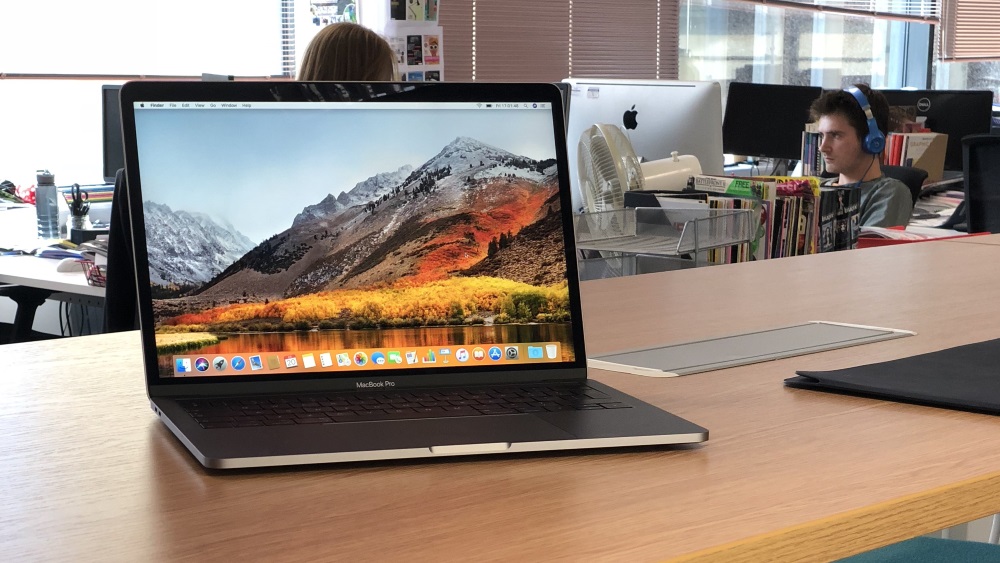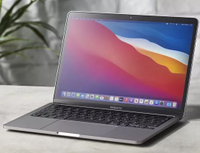TechRadar Verdict
The MacBook Pro with Touch Bar (13-inch, Mid-2018) is a welcome, but mostly straightforward, improvement to a capable laptop.
Pros
- +
Incredibly quick SSD
- +
True Tone for non-visual creativity
- +
Reasonable CPU and GPU boosts
- +
Quad-core processors with Hyper-Threading
Cons
- -
Battery life
- -
Price is close to two grand
Why you can trust TechRadar
The new MacBook Pro (late 2020) is powered by Apple's first laptop processor, the M1. Benchmarks show that it makes a wonderful mobile workstation, a jaw dropping music production notebook and a groundbreaking video editing laptop.
We’re just going to come out and say it: if you weren’t a fan of the new MacBook Pro’s ultra-thin redesign, and its use of Thunderbolt 3 as the exclusive means of connecting things, you won’t change your mind for the MacBook Pro 2018.
However, if having a thin and light laptop with a shallow keyboard doesn’t bother you, and you like macOS, this is a solid but not all-out inspiring improvement.
Apple’s MacBook Pro 2019 could be 16-inches with a totally new design
Apple quietly addressed MacBook Pro 'flexgate' in 2018 models
- Buying Guide: 15 best laptops for most people in 2019
- Buying Guide: 7 best Macs to buy this year
- Buying Guide: The best cheap Macbook deals 2019
However, besides the 15-inch MacBook Pro, only the Touch-Bar equipped 13-inch MacBook Pro gets an upgrade, so if you’re looking to save some cash on a non-Touch Bar model, you’ll have to make do with a dual core processor.
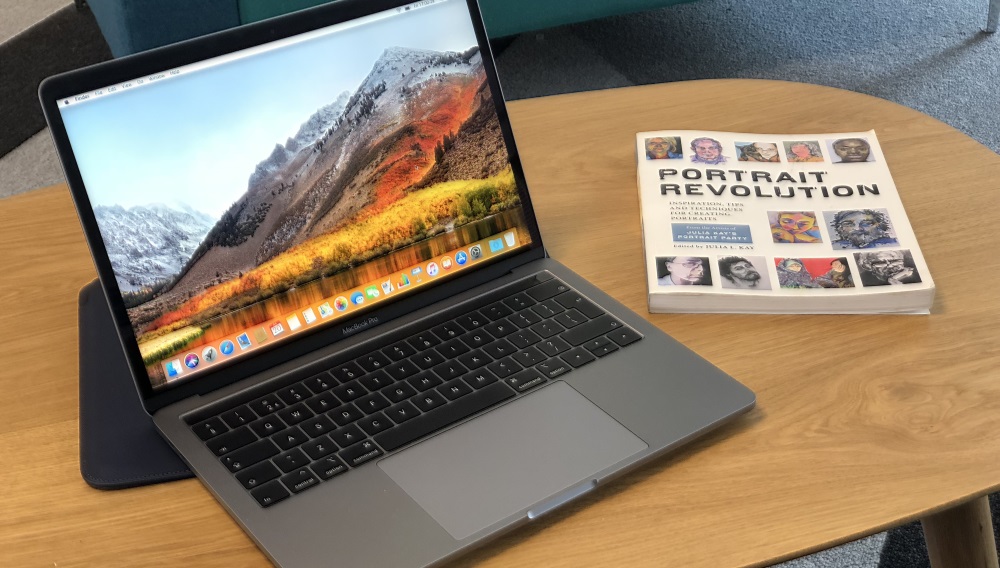
Here is the 13-inch MacBook Pro configuration sent to TechRadar for review:
CPU: 2.7GHz Intel Core i7-8559U (quad-core, 8 threads, 8MB cache, up to 4.5GHz)
Graphics: Intel Iris Plus Graphics 655
RAM: 16GB (2,133MHz LPDDR3)
Screen: 13.3-inch, 2,560 x 1,600 Retina display (backlit LED, IPS, 500 nits brightness, wide color P3 gamut)
Storage: 2TB SSD
Ports: 4x Thunderbolt 3 (USB-C), 3.5mm headphone jack
Connectivity: 802.11ac Wi-F, Bluetooth 5.0
Camera: 720p FaceTime HD webcam
Weight: 3.02 pounds (1.37kg)
Size: 11.97 x 8.36 x 0.59 inches (30.41 x 21.24 x 1.49cm; W x D x H)
Price and availability
Especially now that the MacBook Air 2018 is here, the lower-spec versions aren’t worth your time unless you can find a good deal – they’re still based on 7th-gen Intel Core processors. So, the real starting point for the new MacBook Pro is $1,799 (£1,749, AU$2,699). That price will get you a slightly tight 256GB SSD, and for $1,999 (£1,949, AU$2,999) that SSD goes up to 512GB.
As well as CPU and GPU upgrades that you’ll expect (which we’ll come to later), there’s a small but welcome change to the Thunderbolt 3 ports. Each of the Touch Bar models has four Thunderbolt 3 ports, and in previous versions the two on the right were subject to throttling. That’s no longer the case.
So, if you’ll use an external graphics card (eGPU), you won’t have to think about where you connect it, unlike on 2016 and 2017 models.
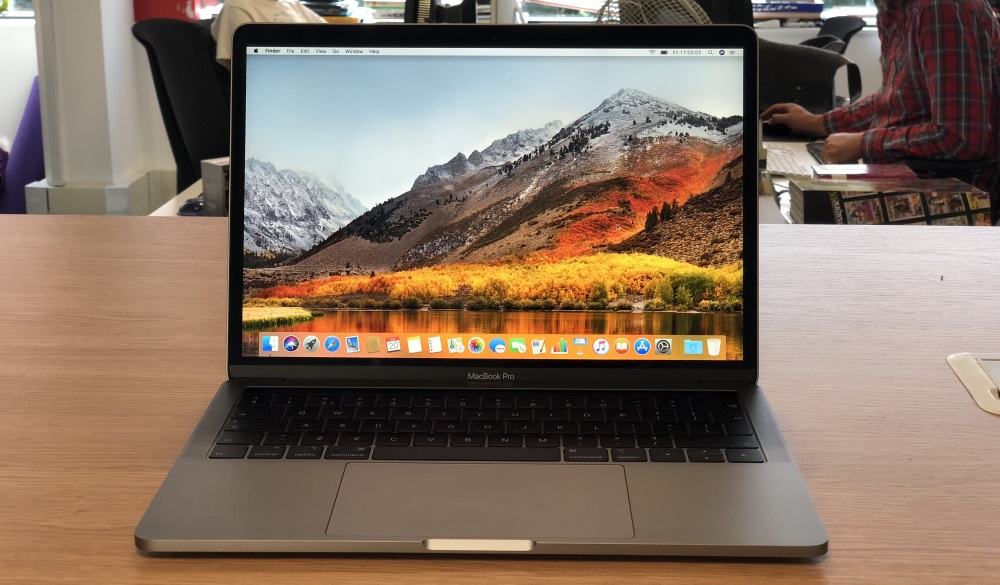
Design
On the outside, the 13-inch MacBook Pro 2018 appears almost identical to last year's model, even down to the similar size and weight. As with 2017’s MacBook Pro, there’s no change to the Retina display’s resolution. The 13.3-inch panel continues to pack 2560x1600 pixels. Some rivals exceeded that even before last year’s models came along, so the 13-inch MacBook Pro loses out on sharpness, but the P3 wide color gamut of Apple’s panel is an attractive proposition for photographic and design work.
There’s one new feature to the display: True Tone, previously available on iPhone X and most iPad Pros, this feature is akin to an enhanced version of the Night Shift setting.
Whereas the latter warms the color temperature late at night through to early morning, True Tone works all day long and goes further; rather than shifting the temperature to a fixed setting, it uses a sensor to read ambient lighting and adjusts the colors on the screen accordingly for your comfort.
Apple provides just one way to toggle True Tone. You have to go into the Displays preferences pane. Though there’s a key combo (Option and the Touch Bar’s screen brightness key) takes you there, we would’ve liked a single key press to toggle the effect at any time.
With over a year’s experience of True Tone on iPad Pro, and slightly less on iPhone X, we’re sold on True Tone’s benefits for non-creative tasks. It’s only when you turn it off in the middle of writing emails, working on a report, or even simply reading web pages that you realise how effective it is – and you’ll want to turn it on again quick sharp.
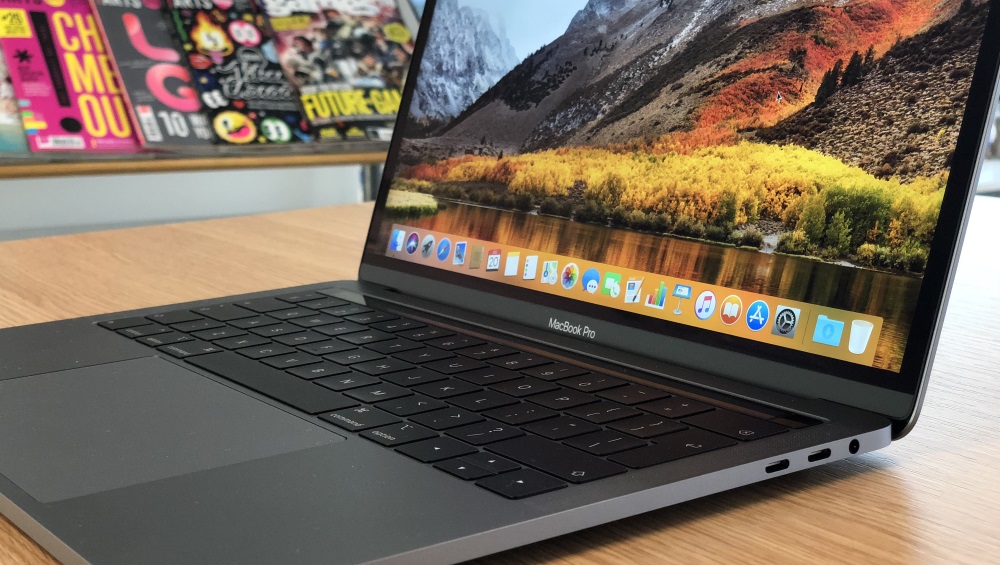
True Tone’s suitability depends on the kind of pro user you are. If you work in any sort of visual art, you’re almost certain to turn it off. Its presence on the 13-inch MacBook Pro ought to be welcomed by students, writers and other mobile workers.
Meanwhile, if you're hoping for a full-on keyboard redesign, then you're out of luck. Keys with low travel remain the order of the day across Apple’s pro-focused laptops. Even after a couple of years with this layout, we trip up when feeling for the arrow keys (full-size left and right ones with half-height up and down sandwiched between). Apple’s marketing mentions just one benefit of the new keyboard: it says it’s quieter.
iFixit’s initial teardown revealed that there’s a silicone membrane between the key caps and the butterfly mechanisms beneath. Anecdotally, typing fast sounds less click-clacky. Whether hammering away at a lengthy document or a quick email, it’s a lot less distracting – or, rather, less distracting for others nearby if you’re working somewhere quiet.
Further testing by the teardown specialist suggests the membrane also brings some success at keeping foreign particles away from the mechanism beneath; that’s said to be a contributor to Apple’s recently introduced repair program for earlier butterfly keyboard designs.
Note, though, that Apple doesn’t make any public claims about durability as a benefit of the third generation. It’ll take the keyboard getting under many more hands to see if reliability complaints persist and to what degree.
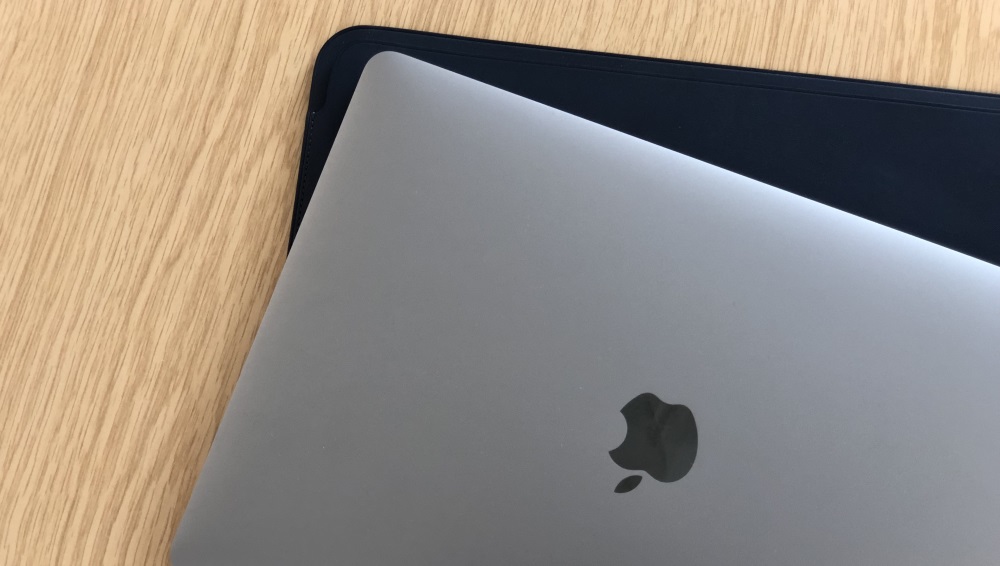
Meanwhile, the Touch Bar remains contentious for many people. Though you can switch it to show function keys or the media, volume and brightness controls, the problem you might run into is more how easy it is, without the tactile response of a key edge, to overreach the actual keys and brush the virtual ones by accident. It takes just light contact to trigger a function by mistake, and we’ve found this most often when trying to delete a character and unexpectedly hearing Siri chime in.
The bar’s value to your workflow depends on whether your apps make good use of it. In Apple’s Pages word processor, for example, you can quickly apply visual changes to selected text without lifting your hands off the keyboard to move the pointer. As the bar is context sensitive, it takes the time of checking what it’s showing at a given time to know where it can save you time.
Using the Touch ID fingerprint reader to quickly resume work is a bonus if you’re tired of typing even your login password. Wearing your Apple Watch (assuming you have one) offers the path of least resistance though – by the time the lid is fully open, you’re in. Disappointed that there’s no Face ID à la iPhone X? That would require a depth-sensing camera upgrade. However, you could argue that the MacBook Pro’s camera could do with a much simpler upgrade from 720p.
Behind the scenes, the Touch Bar as well as Apple’s Secure Boot technology are driven by an upgraded ARM-based processor, the T2, which debuted in the iMac Pro at the end of 2017. You can read about the security benefits of the T2 at Apple’s site.
Where there are obvious improvements that Apple might make to the Touch Bar in the future, it has plenty of leeway when it comes to trackpads. For about a decade, it’s been the clear leader in this area.
We could argue the pros and cons of touchscreen Macs till the cows come home, but the roomy multitouch area in front of the MacBook Pro’s keyboard is comfortable and productive, once you learn a few gestures. We can even forgive the Force Touch feature, partly because it’s so forgettable – just like 3D Touch on recent iPhones – and under-utilised, though using it to preview files and folders or call up dictionary definitions is nice, if you remember it exists – which we tend to when applying extra pressure by accident.
Upgraded internals
A major criticism from high-end pro users has been the MacBook Pro’s 16GB memory limit. Sadly, the 13-inch models haven’t received the boost to DDR4 memory, as their 15-inch siblings have.
Memory on all 13-inch models goes no higher than 16GB, and it’s the same 2,133MHz LPDDR3 type as last year’s models. 8GB remains the starting point across the 13-inch line-up, and fitting more has to be done at the time you buy.
If 8GB seems stingy, when you take the base model as a starting point and match its CPU speed, RAM and SSD capacities to a Surface Book, the MacBook Pro works out around $500/£400/AU$700 more expensive.
But, things aren’t like for like. For starters, the Mac has: double the amount of eDRAM (128MB), a slightly better GPU (an Iris Plus 655 rather than a 640); and the benefit of four ultra-fast and adaptable Thunderbolt 3 ports.
Even so, your opinions on having to buy adapters or a dock to plug in USB-A and other devices might make you unappreciative that Apple doesn’t include an adapter in the box, even though its latest phones recognise that bundling a 3.5mm adapter for headphones, rather than making you pay for one separately, is a decent concession that not everyone will have the latest and greatest accessories to connect.
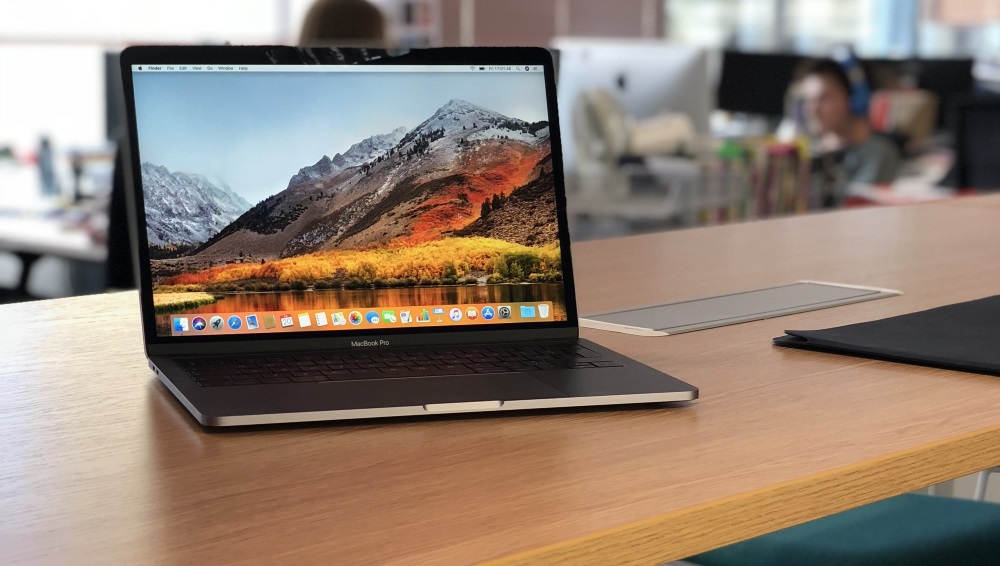
If only Apple would apply that here. Wirelessly transferring files with other Apple devices over AirDrop, or going via the internet, is easy enough, but something it’s still easier to use a USB thumb drive.
A contributor to the MacBook Pro’s cost is its use of superfast NVMe-based storage. Alongside the slimline MacBook Pro design’s introduction in 2016, storage was at that time upgraded to give outrageously fast rates for reading data, exceeding 3GB/sec. That’s true of writing data too.
Our review unit was equipped with a 2TB SSD, so it wasn’t an off-the-shelf configuration, which would be 256GB or 512GB. 2TB is the maximum capacity for the 13-inch MacBook Pro, and it costs $1,400/£1,400/AU$2,100 or $1,200/£1,200/AU$1,800 depending on which respective model you pick as your starting point.
With neither of the standard capacities provided, we have no test results to verify whether their performance also matches Apple’s marketing quote of “up to 3.2GB/sec” read speeds.
Our tests showed a peak read speed of 3,104MB/s (3.1GB/s), so just a little behind Apple’s claim of “up to 3.2GB/sec” for that task. Peak performance when writing was actually more impressive, reaching 3,201.1MB/s (3.2GB/sec). As usual with drives, mean average transfer rates are lower whether reading or writing, managing 2,289.5MB/s and 2,217.3MB/s respectively.
If you’re not sure you need that kind of performance, on the whole you probably don’t. However, it’s a bonus for visual creatives – photographers or videographers who need to get hundreds of gigabytes or even over of a terabyte to a Mac in minimal time, so they can get down to work without waiting for slower storage.
However, there’s another reason that often goes unmentioned that also reduces delays, albeit on a less frequent basis. Whenever you need to restart your Mac (or switch user account), all the apps and windows you had open previously are brought back in quick time. The difference here over even a SATA-connected SSD doesn’t quite rival instant resuming on a tablet, but it’s impressive for eliminating sluggishness.
